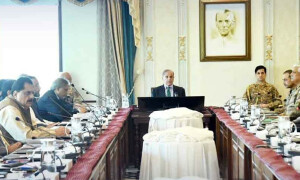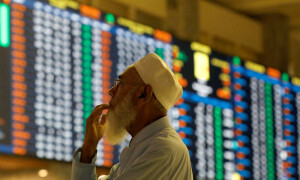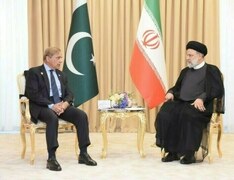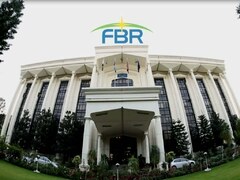The country lies devastated by unprecedented monsoon rains and floods. Over half of Pakistan is under water, leaving desperate victims without hearth, home, food, medicine or any other needed goods and services. Over 30 million (approximately 15 percent of our population) are affected, millions stranded without a way through the raging torrents and no sign or hope of relief.
Whatever rescue and relief efforts have been mounted appear woefully inadequate to the scale of the task. Appeals to the rich to donate to relief efforts have yet to evoke a significant response. International aid is a mere trickle so far, given the west’s obsession with the Russia-Ukraine war.
Admittedly, the scale of the monsoon this year has beggared the imagination. In some areas, estimates speak of four times the normal amount of rain. Given this catastrophe, it would be unrealistic to expect the infrastructure, homes, cattle, crops and human lives not to be swept away in the deluge. However, there is an element of man-made disaster to this natural calamity.
First and foremost, even after the 2010 floods and this year’s repeated warnings of a heavy monsoon, no disaster preparations were evident. The country was too busy, engrossed in the futile verbal duel between the two sides of the political divide. Even after the ‘perfect storm’ struck, it took the federal government days to declare a national emergency.
Tours of the devastated areas by Prime Minister Shehbaz Sharif and COAS General Qamar Javed Bajwa seemingly have yielded little beyond empty assurances of rescue, relief and rehabilitation. Frankly, if the 1,000 dead, 30 million people affected, Rs 10-15 billion economic losses (and counting) are accepted as interim estimates, the true scale of the disaster will only be known when all parts of the country, including those areas that were ‘unreachable’ to begin with, are in a state where accurate assessments can be carried out.
When the 2010 floods struck (and the current ones are much worse), it was reasonable to assume that the government/s would learn from the experience. Yet once again we see the same ad hoc, inadequate response in terms of rescue, relief and (in future) rehabilitation. Clearly the National Disaster Management Agency (NDMA) and the provincial disaster management agencies now run the risk of themselves being dubbed ‘disasters’, with precious little ‘management’ in evidence.
In many parts of the country, unbridled, unplanned (or against the declared plans) development of housing and commercial properties on the banks of rivers and streams has yielded spectacular pictures of big and small buildings collapsing and being swept away by the raging, undeniable torrents. Storm water drains in cities, arguably already inadequate, yielded their share of overflowing water because of the choking by solid waste. Not only rural areas, even urban ones presented the spectre of water, water everywhere and not a drop to drink.
At a time of such a huge natural (and man-made) calamity, it would be reasonable to expect everyone to put other matters aside and focus on the huge task at hand. But at least Imran Khan initially refused to do fund-raising for the flood victims since, he argued, it would detract from his ongoing fund-raising for more cancer hospitals and universities (philanthropic efforts that could, with hindsight, be considered the foundation for his subsequent political career). Later, perhaps because of negative feedback to this indifference towards the suffering of millions of our people in favour of a partisan political agenda, Imran Khan has reversed himself and announced a telethon to raise funds for the flood victims on August 29, 2022.
Nawaz Sharif has sensibly advocated a suspension of political activity in favour of efforts to help the helpless to the extent humanly possible. Maryam Nawaz has come out of her recent repose to start touring the affected areas and people, in Punjab to begin with. The flood victims’ woes are not confined to lack of shelter, food, drinking water and medicine. They are now threatened by waterborne diseases of all descriptions. There are heart rending reports of desperate people being forced to drink flood water, which will no doubt take a toll on their health and wellbeing.
The fallout of the disaster (continuing as these lines are being written) fairly boggles the mind. In a Pakistan in which the people were already groaning under 44 percent annual inflation, the disruption caused by the floods to agricultural crops’ supply promises price rises that will be followed by starvation for the poorest who will not be able to afford the astronomical cost of items crucial to daily existence.
The worst affected province appears to be the least developed — Balochistan. Fourteen dams have reportedly burst, reducing the majority of the province’s areas into seas of seemingly endless water. Roads, rail, gas pipelines, all have been swept away or damaged. The poorest of our people, the Baloch, seem poised to bear the greatest pain. But this takes nothing away from the devastation confronting the populace from Khyber Pakhtunkhwa to Sindh. The wails and cries of the survivors desperately looking for help and succour should rob us of repose and impel us to do whatever we can for as many as possible to help them survive this climate change-induced catastrophe.
Copyright Business Recorder, 2022
[email protected] , rashed-rahman.blogspot.com



























Comments
Comments are closed.